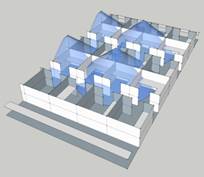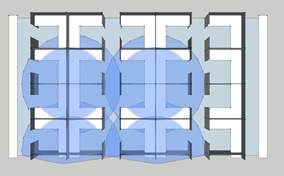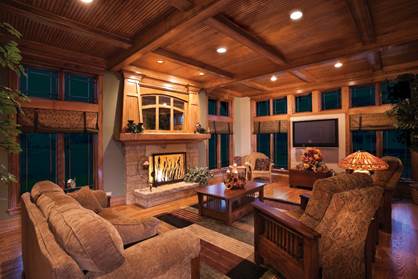

See Section 5.5 of this chapter for the prescriptive daylighting requirements.
A building complies with §140.6 if:
1. The adjusted indoor lighting power of all proposed building areas combined, when calculated in accordance with §140.6(a), is no greater than the allowed indoor lighting power, calculated in accordance with §140.6(c).
2. The calculation of allowed indoor lighting power meets the general rules requirements in §140.6(b).
3. General lighting complies with the automatic daylighting controls in secondary sidelit daylit zones requirements in §140.6(d).
The adjusted indoor lighting power of all building areas is the total watts of all planned permanent and portable lighting systems in all areas of the proposed building.
Some adjustments are available to reduce the indoor lighting power that must be reported. These adjustments are discussed below.
A. Power Adjustment Factors (PAFs) or Reduction of Wattage Through Controls
The Energy Standards provide an option for a lighting power reduction credit when specific lighting controls are installed, provided those lighting controls are not required.
A power adjustment factor (PAF) is an adjustment to the installed lighting power in an area so that some of the installed lighting power is not counted toward the building’s total installed lighting load.
In calculating adjusted indoor lighting power, the installed watts of a luminaire providing general lighting in a functional area listed in Table 140.6-C may be reduced by multiplying the watts controlled by the applicable power adjustment factor (PAF), per Table 140.6-A.
To qualify for a PAF, the following conditions are required to be met:
1. Before a power adjustment factor will be allowed for compliance with §140.6, the person who is eligible under Division 3 of the Business and Professions Code to accept responsibility for the construction or installation of features, materials, components, or manufactured devices, shall sign and submit the Certificate of Installation.
If any of the requirements in this Certificate of Installation are not met, the installation shall not be eligible to use the PAF.
2. Luminaires and controls meet the applicable requirements of §110.9, and §130.0 through §130.5.
3. The controlled lighting is permanently installed general lighting systems and the controls are permanently installed nonresidential-rated lighting controls. (Thus, for example, portable lighting, portable lighting controls, and residential rated lighting controls shall not qualify for PAFs.)
There are furniture mounted lighting systems that are installed to provide general lighting. When used for determining PAFs for general lighting in offices, furniture mounted luminaires that comply with all of the following conditions shall qualify as permanently installed general lighting systems:
a. The furniture mounted luminaires shall be permanently installed no later than the time of building permit inspection.
b. The furniture mounted luminaires shall be permanently hardwired.
c. The furniture mounted lighting system shall be designed to provide indirect general lighting. It may also have elements that provide direct task lighting.
d. Before multiplying the installed watts of the furniture mounted luminaire by the applicable PAF, 0.3 watts per square foot of the area illuminated by the furniture mounted luminaires shall be subtracted from installed watts of the furniture mounted luminaires to account for portable lighting.
e. The lighting control for the furniture mounted luminaire complies with all other applicable requirements in §140.6(a)2.
4. At least 50 percent of the light output of the controlled luminaire is within the applicable area listed in Table 140.6-A. Luminaires on lighting tracks shall be within the applicable area in order to qualify for a PAF.
5. Only one PAF from Table 140.6-A may be used for each qualifying luminaire. PAFs shall not be added together unless specifically allowed in Table 140.6-A.
6. Only lighting wattage directly controlled in accordance with §140.6(a)2 shall be used to reduce the calculated adjusted indoor lighting power as allowed by §140.6(a)2. If only a portion of the wattage in a luminaire is controlled in accordance with §140.6(a)2, then only that portion of controlled wattage may be reduced in calculating adjusted indoor lighting power.
7. Lighting controls used to qualify for a PAF shall be designed and installed in addition to manual, multi-level, and automatic lighting controls required in §130.1, and in addition to any other lighting controls required by the Energy Standards.
8. To qualify for the PAF for daylight dimming plus OFF control, the following requirements must be met:
a. The lighting controls system shall meet all of the requirements of §130.1(d)
b. The lighting control system shall turn lights completely OFF when the daylight available in the daylit zone is greater than 150 percent of the illuminance received from the general lighting system at full power.
c. The controlled luminaires must be within the skylit daylit or primary sidelit daylit zones only.
d. This PAF shall not be available for atria or any other areas that operate with a photocell ON/OFF control that does not include intermediate steps.
e. The OFF step must be demonstrated in the acceptance testing of the automatic daylighting controls.
9. To qualify for the PAF for an occupant sensing control controlling the general lighting in large open plan office areas above workstations, in accordance with Table 140.6-A, the following requirements shall be met:
a. The open plan office area shall be greater than 250 square feet.
b. This PAF shall be available only in office areas which contain workstations.
c. Controlled luminaires shall only be those which provide general lighting directly above the controlled area or furniture mounted luminaires that comply with §140.6(a)2 and provide general lighting directly above the controlled area.
d. Qualifying luminaires shall be controlled by occupant sensing controls that meet the following requirements, as applicable:
i. Infrared sensors shall be equipped (either by the manufacturer or in the field by the installer) with lenses or shrouds to prevent them from being triggered by movement outside of the controlled area.
ii. Ultrasonic sensors shall be tuned to reduce their sensitivity to prevent them from being triggered by movements outside of the controlled area.
iii. All other sensors shall be installed and adjusted as necessary to prevent them from being triggered by movements outside of the controlled area.
e. The PAF shall be applied only to the portion of the installed lighting power that is controlled by the occupant sensors, not to the total installed lighting power.
f. The value of the PAF (0.2, 0.3 or 0.4) depends on the square footage controlled by each occupant sensor.
Figure 5-15: To Qualify for the PAF for Occupancy Sensing Controls in Open-Plan Offices, Sensors Must be Tuned to the Controlled Area


10. The following requirements must be met to qualify the PAF for institutional tuning,:
a. The lighting controls shall limit the maximum output or maximum power draw of the controlled lighting to 85 percent or less of full light output or full power draw.
b. The means of setting the limit is accessible only to authorized personnel.
c. The setting of the limit is verified by the acceptance test required by §130.4(a)7.
d. The construction documents specify which lighting systems shall have their maximum light output or maximum power draw set to no greater than 85 percent of full light output or full power draw.
11. To qualify for the PAF for a demand responsive control in Table 140.6-A, a demand responsive control shall meet all of the following requirements:
a. Because buildings larger than 10,000 sq. ft. are required to have demand responsive controls, to qualify for the PAF, the building shall be 10,000 sq ft or smaller.
b. The controlled lighting shall be capable of being automatically reduced in response to a demand response signal.
c. Lighting shall be reduced in a manner consistent with the uniform level of illumination requirements in Table 130.1-A.
d. Spaces that are non-habitable shall not be used to comply with this requirement, and spaces with a lighting power of less than 0.5 watts per square foot shall not be counted toward the building’s total lighting power.
12. Daylighting devices for PAFs are newly introduced in the 2019 standards.
To qualify for the PAF for daylighting devices (including clerestories, light shelves and horizontal slats in Table 140.6-A), the daylighting devices must meet the requirements in Section 140.3(d). Refer to Chapter 3 of the Nonresidential Compliance Manual about Section 140.3(d).
Also note that the PAFs shall only apply to luminaires in the daylit areas adjacent to the daylighting devices, and to the lighting system meeting the automatic daylighting controls requirements of Section 130.1(d).
B. Luminaire Power Adjustment
Color-tunable LED lighting technologies are adopted for lighting applications including hospitality and healthcare and other built environments. Those luminaires offer the benefits of producing different correlated color temperatures (CCT) to match the functionality and occasions of a space.
Two categories of the color tunable luminaires -- tunable-white LED and dim-to-warm LED luminaires -- can be qualified for luminaire lighting power adjustment by a multiplier of 0.75 if the luminaires meet all of the requirements of Section 140.6(a)4B. The requirements are paraphrased below.
•Small Aperture – no wider than 4 inches for luminaires longer than 18 inches; no wider than 8 inches otherwise.
•Color Changing Capability– capable of color change greater than or equal to 2000K CCT for tunable-white LED luminaires; capable of color change greater than or equal to 500K CCT for dim-to-warm LED luminaires.
•Control Capability – the luminaires must be connected with controls enabling color-changing.
Figure 5-16 Dim-to-warm luminaires in Lighting Applications

Source: NORA Lighting
C. Portable Lighting in Office Areas
The Energy Standards (§140.6(a)) require that all planned portable lighting be counted toward the building’s lighting energy use, regardless of when it is planned to be installed.
Because office cubicles (including their portable lighting) are typically not installed until after the building inspection is complete, the portable lighting power is accounted together with permanent lighting system as the adjusted lighting power for compliance purpose.
The Energy Standards define portable lighting as lighting with plug-in connections for electric power. That includes table and freestanding floor lamps; those attached to modular furniture; workstation task luminaires; luminaires attached to workstation panels; those attached to movable displays; or those attached to other personal property.
D. Two Interlocked Lighting Systems
I. Within the following five functional areas, as defined in §100.1, two lighting systems may be installed provided they are interlocked so that both lighting systems cannot operate simultaneously. All other functional areas are permitted to install only one lighting system.
1. Auditorium
2. Convention center
3. Conference room
5. Theater
II. No more than two lighting systems may be used for these five specifically defined functional areas, and if there are two lighting systems, they must be interlocked.
III. Where there are two interlocked lighting systems, the wattage of the lower system may be excluded from determining the adjusted indoor lighting power if:
1. Before two interlocked lighting systems will be recognized for compliance with the lighting requirements in Part 6 of Title 24, the person who is eligible under Division 3 of the Business and Professions Code to accept responsibility for the construction or installation of features, materials, components, or manufactured devices shall sign and submit the Certificate of Installation.
If any of the requirements in the Certificate of Installation are not met, the two interlocked lighting systems shall not be recognized for compliance with the lighting standards.
2. The two lighting systems shall be interlocked with a nonprogrammable double-throw switch to prevent simultaneous operation of both systems.
3. For compliance with the Energy Standards a nonprogrammable double-throw switch is an electrical switch commonly called a "single pole double throw" or "three-way" switch that is wired as a selector switch allowing one of two loads to be enabled. It can be a line voltage switch or a low voltage switch selecting between two relays. It cannot be overridden or changed in any manner that would permit both loads to operate simultaneously.
E. Lighting Wattage Not Counted Toward Building Load
The Energy Standards do not require lighting power of certain types of luminaires in specific functional areas or for specific purposes, to be counted toward a building’s installed lighting power.
Any nonresidential indoor lighting function not specifically listed below shall comply with all applicable nonresidential indoor lighting requirements. For example, lighting in guestrooms of hotels is not required to be counted for compliance with §140.6. However, lighting in all other function areas within a hotel are required to comply with all applicable requirements in §140.6. Also, lighting within guestrooms is regulated by the low-rise residential lighting standards.
The wattage of the following indoor lighting applications are not required to be counted toward the adjusted (installed) indoor lighting power:
•In theme parks: lighting for themes and special effects.
•Studio lighting for film or photography provided that these lighting systems are in addition to, and separately switched from a general lighting system.
•Lighting for dance floors, lighting for theatrical and other live performances, and theatrical lighting used for religious worship provided that these lighting systems are additions to a general lighting system and are separately controlled by a multi-scene or theatrical cross-fade control station accessible only to authorized operators.
•Lighting intended for makeup, hair, and costume preparation in performance arts facility dressing rooms. That lighting must be separately switched from the general lighting system, switched independently at each dressing station, and controlled with a vacancy sensor.
•In civic facilities, transportation facilities, convention centers, and hotel function areas: Lighting for temporary exhibits, if the lighting is an addition to a general lighting system and is separately controlled from a panel accessible only to authorized operators.
•Lighting installed by the manufacturer in walk-in freezers, vending machines, food preparation equipment, and scientific and industrial equipment.
•In medical and clinical buildings: Examination and surgical lights, low-ambient night-lights, and lighting integral to medical equipment, provided that these lighting systems are additions to and separately switched from a general lighting system.
•Lighting for plant growth or maintenance, if it is controlled by a multi-level astronomical time-switch control that complies with the applicable provisions of §110.9.
•Lighting equipment that is for sale.
•Lighting demonstration equipment in lighting education facilities.
•Lighting that is required for exit signs subject to the CBC. Exit signs shall meet the requirements of the Appliance Efficiency Regulations.
•Exit way or egress illumination that is normally off and that is subject to the CBC.
•In hotel/motel buildings: Lighting in guestrooms (lighting in hotel/motel guestrooms shall comply with §130.0(b). (Indoor lighting not in guestrooms shall comply with all applicable nonresidential lighting requirements in Part 6.)
•In high-rise residential buildings: Lighting in dwelling units (Lighting in high-rise residential dwelling units shall comply with §130.0(b).) (Indoor lighting not in dwelling units shall comply with all applicable nonresidential lighting requirements in Part 6.)
•Temporary lighting systems. Temporary Lighting is defined in §100.1 as a lighting installation with plug-in connections, which does not persist beyond 60 consecutive days or more than 120 days per year.
•Lighting in occupancy group U buildings less than 1,000 sq. ft.
•Lighting in unconditioned agricultural buildings less than 2,500 sq. ft.
•Lighting systems in qualified historic buildings, as defined in the State Historic Building Code (Title 24, Part 8), are exempt from the Lighting Power allowances if they consist solely of historic lighting components or replicas of historic lighting components. If lighting systems in qualified buildings contain some historic lighting components or replicas of historic components, combined with other lighting components, only those historic or historic replica components are exempt. All other lighting systems in qualified historic buildings shall comply with the lighting power allowances.
•Lighting in nonresidential parking garages for seven or fewer vehicles: Lighting in nonresidential parking garages for seven or fewer vehicles shall comply with the applicable residential parking garage provisions of §150.0(k).
•Lighting for signs: Lighting for signs shall comply with §140.8.
•Lighting in refrigerated cases less than 3,000 square feet. (Lighting in refrigerated cases less than 3,000 sq ft. shall comply with Title 20 Appliance Efficiency Regulations).
•Lighting in elevators where the lighting meets the requirements in §120.6(f).